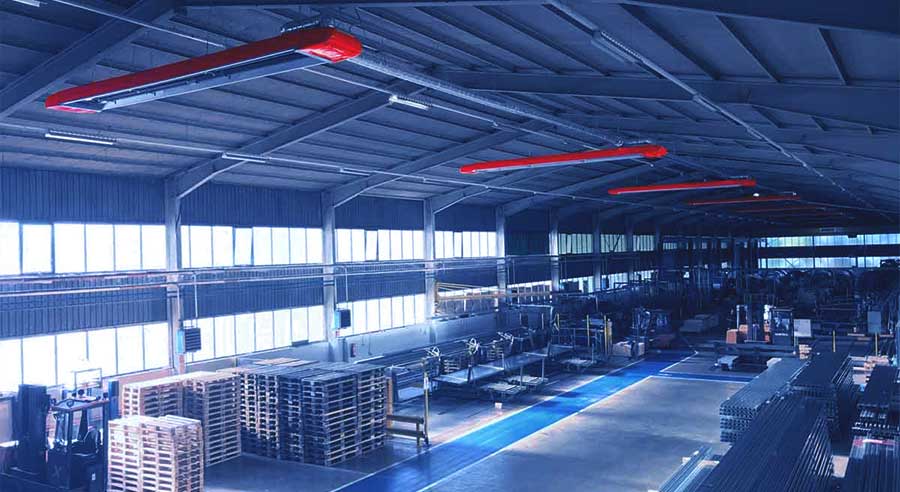Heating with infrared dark radiators: These facts you should know!
A new heating system for your company's production is a decision that needs to be well thought out. After all, it's not just about warm halls. There is much more behind it:
- Saving heating costs sensibly
- Increase energy efficiency
- Create thermal comfort at the workplace
- Ensure operational flexibility and
- Meet environmental and legal requirements
Are you thinking about whether infrared radiant heaters are the right choice? Then these following facts should make your decision easier!
How infrared tube heaters work
Before we get into the hard facts, let's first clarify two basic questions and clear up common misconceptions. What are radiant heaters and what distinguishes infrared dark radiators from bright radiators?
Many answers you find on the Internet about this are not very enlightening or are simply nonsense. Correct is: Both light and dark radiators are radiant heaters, since with them the heat transfer takes place almost exclusively by infrared radiation. For this purpose, natural gas or liquid gas are usually used as energy sources. However, biogas or hydrogen, e.g. from regenerative sources, also have great potential for the future.
Dark radiators use closed combustion in a pipe system. Light radiators work with open combustion. The main difference is therefore in the way the combustion exhaust gases are handled: With light emitters, these initially remain in the hall atmosphere. For this reason, sufficient ventilation must be provided for these systems. In the case of infrared dark radiators, the exhaust air is discharged to the outside via an exhaust system - without polluting the hall atmosphere. This is why the use of dark radiators is the preferred choice in most applications today.
In both systems, the heat generated is directed as infrared radiation into the areas to be heated. Similar to solar radiation, heat is generated as soon as the infrared rays hit bodies or objects. Thus, among other things, the hall floor, the room frame and the people in the working area are heated directly.
The special thing about it is that dark radiators do not heat any ambient air with their infrared radiation, but only directly that which is actually to be heated. Thus there are also virtually no warm air which, for physical reasons, rises under the hall roof instead of remaining in the working area. This is precisely the decisive advantage of infrared emitters in terms of efficiency.
No hot air - no air movement
Wherever there's planing, there's cutting. Or a lot of dust is produced. This dust is stirred up by conventional hot-air heating systems often used in halls. This is a problem in many companies, but it can easily be counteracted with infrared dark radiators. These do not heat the air and therefore no drafts can arise or dust can be stirred up. For your employees and visitors, this means a healthy, dust- and draft-free working atmosphere.
Infrared dark radiators heat particularly efficiently
Let's stay briefly with warm air heaters, which are commonly used in industrial and commercial halls. Simple physics quickly makes it clear that these are not particularly efficient for heating large halls: After all, the heated air rises straight up. To ensure that it is warm not only under the roof but also in the actual usable zone of the hall, the air must be continuously reheated. If the hall door is constantly open or the hall is outdated and insufficiently insulated, this results in an enormous waste of energy and money.
Infrared dark radiators, on the other hand, only heat - as already described - the objects and bodies they hit. And if no warm air is produced, no warm air can escape. In addition, the operation of dark radiators can be flexibly adapted to a wide variety of situations that arise when working in halls by means of an appropriately intelligent control system:
- Gate opening times
- Working and shift times
- Different usable zones of the hall, in which different amounts of heat are also required
Infrared radiant heaters are therefore particularly efficient. Expressed in clear figures: they consume up to 70 % less energy than conventional systems. Modern infrared radiant heaters are therefore currently the most efficient heating systems for industrial and commercial buildings. And this means that you not only recoup the initial costs quickly, but also do something good for the environment.
Dark radiators are an investment that pays off. Right from the start.
One mistake that is made particularly often in the planning of hall heating systems is a lack of vision of the big picture. The new devices should be as inexpensive as possible in terms of investment - and this pays off in the long run if the consumption costs are disregarded. After all, a hall heating system consumes x times its investment costs over its life cycle. It is therefore important to focus on life cycle costs. The keyword here is: low TCO - Total Costs of Ownership. You can save (or even spend!) a lot of money at the wrong end without it being really effective in the end.
So which heating system is worth it - even in the long run? The answer is: the heater that best fits your usage profile and meets your economic requirements. Infrared dark radiators are characterized by low investment costs compared to many other systems. This is confirmed by the results of a study we conducted together with the Technical University of Kaiserslautern. Investment costs for the use of regenerative energies such as a heat pump in conjunction with underfloor heating or a wood pellet stove coupled with radiant ceiling panels are between a factor of 1, 8 to 4.0 - on average a factor of 3.0! - higher than with a dark radiator system with residual heat utilization.
Regenerative energies are all well and good in residential construction, but in halls they clearly lag behind the specially developed dark radiators. This is because renewable energies differ functionally from classic energy sources in one important point, and that is the low temperature level. This low temperature level always ties renewable energies to hydraulic solutions, at the end of which is warm air. And warm air as heat transfer in high spaces is dysfunctional, as we have already seen. Who benefits from generating a lot of renewable energy for a lot of money, which then does not develop the necessary heat at the workplace? Halls have completely different conditions due to the significantly higher rooms.
In addition, infrared dark radiators score - as already mentioned - with their high efficiency and low annual energy requirement. The investment costs are amortized after just a few years. A dark radiator therefore clearly pays for itself in most halls.
Achieve personal and energy goals with dark radiators
No matter whether your hall is four, ten or more meters high: dark radiators are a sustainable investment that will not only increase the satisfaction and productivity of your employees, but will also help you meet energy policy targets thanks to their high efficiency. Please feel free to inform yourself here. If you would like to talk about specific plans right now, let's have a conversation and discuss the different requirements of your industry.




